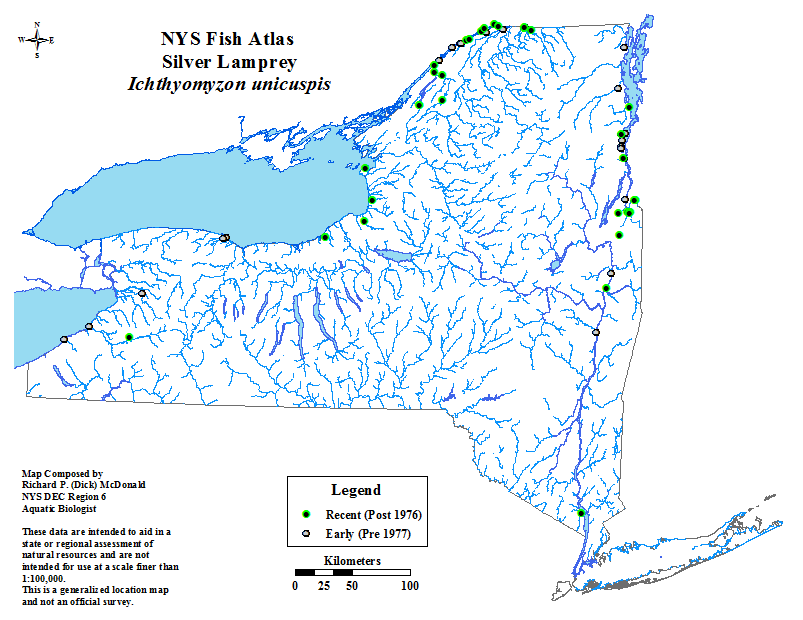
Silver Lamprey (Ichthyomyzon unicuspis)
The silver lamprey is generally distributed along the Great Lakes and in the large tributaries of the Mississippi and Ohio Rivers from Minnesota to Nebraska, Tennessee and West Virginia. There are isolated records from the Hudson Bay drainage and the Mississippi River in the State of Mississippi. Their abundance in Ohio decreased drastically between 1920 and 1945.
In New York State, there are records from Lakes Erie and Ontario, the St. Lawrence drainage, and Lake Champlain and its tributaries. The Biological Survey (undertaken in the 1920's and 1930's in New York) reported it as common in Lake Champlain with spawning observed in Putnam Creek and the Lower Ausable River. We did not find it in Putnam Creek in 1978, but we did find ammocoetes of Petromyzon near Crown Point. It has been taken in the Hudson River near Stillwater and, recently, specimens have been collected in the Lower Hudson near Albany and Nyack. Quite probably their presence in the Lower Hudson is due to their having passed through the Champlain-Hudson Canal.
The parasitic adults live in larger streams and lakes where they find their fish hosts. Spawning takes place in moderate-sized streams where there are sand- and gravel-bottom riffles. The ammocoetes require sand and dark mud that is relatively free of clay silt.
Spawning occurs in May and June when the water temperature reaches 50 F.The nests are built in shallow gravelly riffles and spawning is similar to that of the sea lamprey. At times, they share the nests of sea lampreys, The adults constantly work on the nests with short interruptions for spawning. The female attaches to a rock and the male attaches to her head, wrapping his tail around hers to bring the genital openings close together. The pair vibrates as the eggs and sperm are released; then they separate and return to nest building. The adults die when spawning is completed. A nest was found in Putnam Creek on 18 June when the water temperature was 72 F. Six adults were under a large stone at the head of a riffle where the water was about 8 inches deep. Apparently, they had hollowed out a cavity as a nest. The eggs of the silver lamprey are approximately 1mm in diameter and the average female produces 10,800 eggs. After hatching, the ammocoetes drop downstream to quiet water where they burrow into the mud. It is estimated that the larval period lasts 4 to 7 years. They transform in the fall when they are about 3 inches long. They remain in the streams over winter, then move downstream to rivers and lakes where they find hosts. After 1 or possibly 2 years as parasites, they return to the streams to spawn and die.
Ammocoetes feed on drifting plankton and detritus. Adults attack a variety of fish including trout, whitefish, smelt, pike, white sucker, black buffalo, brown bullhead, carp, rock bass, walleye, paddlefish and even such armored species as sturgeons and gars.
Distribution of silver lamprey in NY state.
An image of the silver lamprey is also available for download
The above species description was taken out of "The Inland Fishes of New York State" by C. Lavett Smith, published by the New York State Department of Environmental Conservation, 1985.
